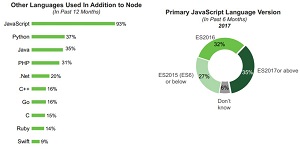News
AWS Cloud Favored for Node.js Deployment, Survey Says
- By David Ramel
- June 8, 2018
The Node.js Foundation published its third annual user survey, revealing that the Amazon Web Services (AWS) cloud is the primary deployment target for Node.js production code.
For development, however, most Node.js coders favor on-premises infrastructure, ahead of AWS.
Those findings were presented in the new 2018 Node.js User Survey Report, the third consecutive year the Node.js Foundation has sought input on use of the open source, cross-platform JavaScript run-time environment, this year from 1,626 respondents.
"The largest percentage of users deploy on Amazon Web Services followed by on-premise infrastructure," the report said. "Though a significant number of users deploy to Heroku, DigitalOcean, Google Cloud Platform and Microsoft Azure."
The deployment findings closely mirror last year's report, as do findings on programming languages used and OSes used for production and development.
For production, 39 percent of this year's respondents reported using the Ubuntu Linux distro, compared to 42 percent last year. Debian-based Linux distros came in at second place both years.
For deployment, 41 percent of this year's respondents use macOS, compared to 46 percent last year. One change in the rankings this year is that Windows took over second place for development OS (24 percent), edging Ubuntu (21 percent). Last year it was Ubuntu at 20 percent and Windows at 18 percent.
 [Click on image for larger view.] Node.js Deployment Targets (source: Node.js Foundation).
[Click on image for larger view.] Node.js Deployment Targets (source: Node.js Foundation).
For programming languages used, JavaScript is obviously the No. 1 choice by far. "Node.js users are using a range of other languages besides Node -- more than 3 on average, including primarily JavaScript, Python, Java and PHP," the report said. Among other languages used, the order this year was Python (37 percent), Java (35 percent) and PHP (31 percent). Those numbers are almost identical to last year.
Further exploring the use of other languages, the report pointed out:
A third are using ES2017 or above -- three times as many as with last year.
APAC users use fewer languages on average than others, while those outside traditional development areas use more -- particularly C++ and C.
Most expect to increase their use of Node.js over the next 12 months – and the number is rising. Growth will likely come from outside the US/CA -- particularly in Latin America or EMEA.
Use of other languages is also expected to increase -- including Rust, Go and JavaScript.
Usage of Ruby has dropped, and users are far more likely to say they will "decrease" usage than increase over the next 12 months.
PHP is less popular in US/CA and among "other" developers; and, many of those who use it say they will decrease usage over the next 12 months.
Go and Swift may be stealing the attention of Node.js users -- many of those who plan to maintain/decrease with Node.js will increase with Go or Swift in the next 12 months.
 [Click on image for larger view.] Programming Languages Used (source: Node.js Foundation).
[Click on image for larger view.] Programming Languages Used (source: Node.js Foundation).
Other highlights from the 2018 survey include these callouts:
- Web apps remain the most popular use case for Node, with 85 percent of respondents indicating they use Node for this work. 43 percent of respondents indicate they use Node for enterprise applications.
- Integration with databases, front-end frameworks and load balancing are at the forefront of the range of technologies integrated with Node.js.
- Most users expect to increase their use of Node.js, particularly in Latin America and EMEA.
- Babel is the leading transpiler, but back-end, full stack and ‘other' developers are increasing their use of Typescript. Among Module Bundlers, Webpack seems to be consolidating its lead across most regions and development areas.
- It is becoming increasingly important to users to manage different packages for multiple environments. npm is by far the most widely used package manager, but Yarn is gaining in popularity in many segments.
The study was conducted online from Oct 5, 2017, to January 7, 2018, via a self-administered survey (distributed through a number of channels including e-mail, Twitter, conferences, blogs and word of mouth such as at meet-ups) fielded in English and Chinese.
This year's survey is available here. Last year's survey is available here. The 2016 survey is available here.
About the Author
David Ramel is an editor and writer at Converge 360.